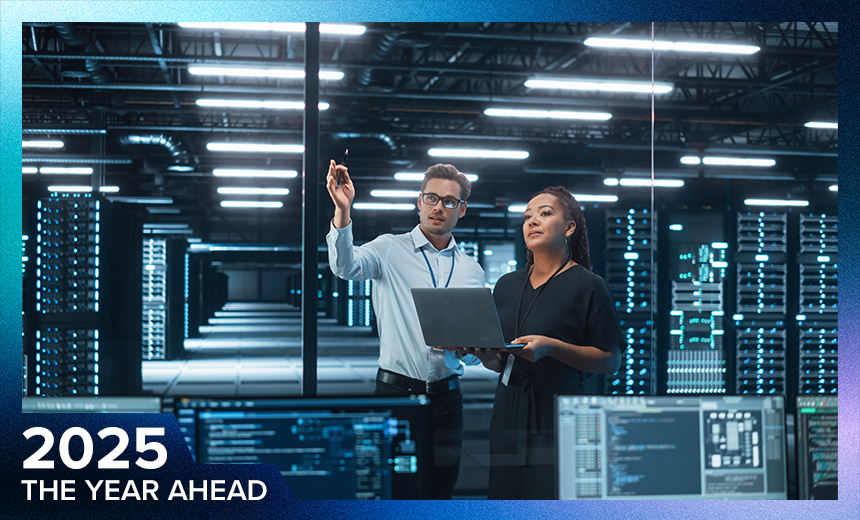Tech predictions 2025 – what could be in store next year?

In 2025, we will hear of numerous cases where threat actors trick a corporate
Gen AI solution into giving up sensitive information and causing high-profile
data breaches. Many enterprises are using Gen AI to build customer-facing
chatbots, in order to aid everything from bookings to customer service. Indeed,
in order to be useful, LLMs must ultimately be granted access to information and
systems in order to answer questions and take actions that a human would
otherwise have been tasked with. As with any new technology, we will witness
numerous corporations grant LLMs access to huge amounts of potentially sensitive
data, without appropriate security considerations. ... The future of work
won’t be a binary choice between humans or machines. It will be an “and.”
AI-powered humanoids will form a part of the future workforce, and we will
likely see the first instance happen next year. This will force companies to
completely reimagine their workplace dynamics – and the technology that powers
them. ... At the same time, organisations must ensure their security postures
keep pace. Not only to ensure the data being processed by humanoids is kept
safe, but also to keep the humanoids safeguarded from hacking and threatening
tweaks to their software and commands.
7 Private Cloud Trends to Watch in 2025

A lot of organizations are repatriating workloads to private cloud from public
cloud, but Rick Clark, global head of cloud advisory at digital transformation
solutions company UST warns they aren’t giving it much forethought, like they
did earlier when migrating to public clouds. As a result, they’re not getting
the ROI they hope for. “We haven’t still figured out what is appropriate for
workloads. I’m seeing companies wanting to move back the percentage of their
workload to reduce cost without really understanding what the value is so
they’re devaluing what they're doing,” says Clark. ... Artificial intelligence
and automation are also set to play a crucial role in private cloud management.
They enable businesses to handle growing complexity by automating resource
optimization, enhancing threat detection, and managing costs. “The ongoing
talent shortage in cybersecurity makes [AI and automation] especially valuable.
By reducing manual workloads, AI allows companies to do more with fewer
resources,” says Trevor Horwitz, CISO and founder at cybersecurity, consulting,
and compliance services provider. ... Security affects all aspects of a cloud
journey, including the calculus of when and where to use private cloud
environments. One significant challenge is making sure that all layers of the
stack have detection and response capability.
Agility in Action: Elevating Safety through Facial Recognition

Facial Recognition Technology (FRT) stands out as a leading solution to these
problems, protecting not only the physical boundaries but also the
organization’s overall integrity. Through precise identity verification and user
validation, FRT considerably lowers the possibility of unauthorized access.
Organizations, irrespective of size, can benefit from this technology, which
offers improved security and operational effectiveness. ... A comprehensive
physical security program with interconnected elements serves as the backbone of
any security infrastructure. Regulating who can enter or exit a facility is
vital. Effective systems include traditional mechanical methods, such as locks
and keys, as well as electronic solutions like RFID cards. By using these
methods, only authorized persons are able to enter. Nonetheless, a technological
solution that works with many Original Equipment Manufacturers (OEMs) is
required to successfully counter today’s dangers. In addition to guaranteeing
general user convenience, this technology should give top priority to data
privacy and safety compliance.
Effective physical security is built on
deterring unauthorized entry and identifying people of interest. This can
include anything from physical security personnel to surveillance and access
control systems.
Strategies for Managing Data Debt in Growing Organizations
Not all data debt is created equal. Growing organizations experiencing data
sprawl at an expanding rate must conduct a thorough impact assessment to
determine which aspects of their data debt are most harmful to operational
efficiency and strategic initiatives. An effective approach involves quantifying
the potential risks associated with each type of debt – such as compliance
violations or lost customer insights – and calculating the opportunity cost of
maintaining versus mitigating them. ... A core approach to managing data debt is
to establish strong data governance practices that address inconsistencies and
fragmentation. Before anything else, you must establish an adequate access
control system and ensure its imperviousness. Next, you must think about
implementing robust validation mechanisms that will help prevent further debt
accumulation. Data governance frameworks provide a foundation for minimizing ad
hoc fixes, which are the primary drivers of data debt. ... An architectural
shift that facilitates scalability can help avoid the bottlenecks that arise
when data outgrows its infrastructure. Technologies like cloud platforms offer
scalability without heavy up-front investments, allowing organizations to expand
their capacity in line with their growth.
Secure by design vs by default – which software development concept is better?

The challenge here is that, while from a security perspective we may agree that
it is wise, it could inevitably put developers and vendors at a competitive
disadvantage. Those who don’t prioritize secure-by-design can get features,
functionality, and products out to market faster, leading to potentially more
market share, revenue, customer attraction/retention, and more. Additionally,
many vendors are venture-capital backed, which comes with expectations of return
on investment — and the reality that cyber is just one of many risks their
business is facing. They must maintain market share, hit revenue targets,
deliver customer satisfaction, raise brand awareness/exposure, and achieve the
most advantageous business outcomes. ... Secure-by-default development
focuses on ensuring that software components arrive at the end-user with all
security features and functions fully implemented, with the goal of providing
maximum security right out of the box. Most cyber professionals have experienced
having to apply CIS Benchmarks, DISA STIGs, vendor guidance and so on to harden
a new product or software to ensure we reduce its attack surface.
Secure-by-default flips that paradigm on its head so that products arrive
hardened and require customers to roll back or loosen the hardened
configurations to tailor them to their needs.
The modern CISO is a cornerstone of organizational success
Historically, CISOs focused on technical responsibilities, including managing
firewalls, monitoring networks, and responding to breaches. Today, they are
integral to the C-suite, contributing to decisions that align security
initiatives with organizational goals. This shift in responsibilities reflects
the growing realization that security is not just an IT function but a critical
enabler of business goals, customer trust, and competitive advantage. CISOs are
increasingly embedded in the strategic planning process, ensuring that
cybersecurity initiatives support overall business goals rather than operate as
standalone activities. ... One of the most critical aspects of the modern CISO
role is integrating security into operational processes without disrupting
productivity. This involves working closely with operations teams to design
workflows prioritizing efficiency and security. This aspect of their
responsibility ensures that security does not become a bottleneck for business
operations but enhances operational resilience, efficiency, and productivity.
... The CISO of tomorrow will redefine success by aligning cybersecurity with
business objectives, fostering a culture of shared responsibility, and driving
resilience in the face of emerging risks like AI-driven attacks, quantum
threats, and global regulatory pressures.
Key Infrastructure Modernization Trends for Enterprises

Cloud providers and data centers need advanced cooling technologies, including
rear-door heat exchange, immersion and direct-to-chip systems. Sustainable power
sources such as solar and wind must supplement traditional energy resources.
These infrastructure changes will support new chip generations, increased rack
densities and expanding AI requirements while enabling edge computing use cases.
"Liquid cooling has evolved to move from cooling the broader data center
environment to getting closer and even within the infrastructure," Hewitt said.
"Liquid-cooled infrastructure remains niche today in terms of use cases but will
become more predominant as next generations of GPUs and CPUs increase in power
consumption and heat production." ... Document existing business processes
and workflows to improve visibility and identify gaps suitable for AI
implementation. Organizations must organize data for AI tools that can bring in
improvements, keep track of where the data resides to organize it for AI use,
build internal guidelines for training and testing AI-driven workflows, and
create robust controls for processes that incorporate AI agents.
Being Functionless: How to Develop a Serverless Mindset to Write Less Code!
As the adoption of FaaS increased, cloud providers added a variety of language
runtimes to cater to different computational needs, skills, etc., offering
something for most programmers. Language runtimes such as Java, .NET, Node.js,
Python, Ruby, Go, etc., are the most popular and widely adopted. However, this
also brings some challenges to organizations adopting serverless technology.
More than technology challenges, these are mindset challenges for engineers.
... Sustainability is a crucial aspect of modern cloud operation. Consuming
renewable energy, reducing carbon footprint, and achieving green energy
targets are top priorities for cloud providers. Cloud providers invest in
efficient power and cooling technologies and operate an efficient server
population to achieve higher utilization. For this reason, AWS recommends
using managed services for efficient cloud operation, as part of their
Well-Architected Framework best practices for sustainability. ... For
engineers new to serverless, equipping their minds to its needs can be
challenging. Hence, you hear about the serverless mindset as a prerequisite to
adopting serverless. This is because working with serverless requires a new
way of thinking, developing, and operating applications in the cloud.
Unlocking opportunities for growth with sovereign cloud

Although there is no standard definition of what constitutes a “sovereign
cloud,” there is a general understanding that it must ensure sovereignty at
three fundamental levels: data, operations, and infrastructure. Sovereign
cloud solutions, therefore, have highly demanding requirements when it comes
to digital security and the protection of sensitive data, from technical,
operational, and legal perspectives. The sovereign cloud concept also opens up
avenues for competition and innovation, particularly among local cloud service
providers within the UK. In a recent PwC survey, 78% of UK business leaders
said they have adopted cloud in most or all areas of their organisations.
However, many of these cloud providers operate and function outside of the
country, usually across the pond. The development of sovereign cloud offerings
provides the perfect push for UK cloud service providers to increase their
market share, providing local tools to power local innovation. For a
large-scale, accessible, and competitive sovereign cloud ecosystem to emerge,
a combination of certain factors is essential. Firstly, partnerships are
crucial. Developing local sovereign cloud solutions that offer the same
benefits and ease of use as large hyperscalers is a significant challenge.
The Tipping Point: India's Data Center Revolution
"Data explosion and data localization are paving the way for a data center
revolution in India. The low data tariff plans, access to affordable
smartphones, adoption of new technologies and growing user base of social
media, e-commerce, gaming and OTT platforms are some of the key triggers for
data explosion. Also, AI-led demand, which is expected to increase multi-fold
in the next 3-5 years, presents significant opportunities. This, coupled with
favourable regulatory policies from the Central and State governments, the
draft Digital Personal Data Protection Bill, and the infrastructure status are
supporting the growth prospects," said Anupama Reddy, Vice President and
Co-Group Head - Corporate Ratings, ICRA. ... The high-octane data center
industry comes with its own set of challenges. The data center industry faces
high operational costs alongside challenges in scalability, cybersecurity,
sustainability, and skilled workforce. Power and cooling are major cost
drivers, with data centers consuming 1-1.5 per cent of global electricity.
Advanced cooling solutions and energy-efficient hardware can help reduce
energy costs while supporting environmental goals.
Quote for the day:
"In the end, it is important to
remember that we cannot become what we need to be by remaining what we are."
-- Max De Pree
No comments:
Post a Comment